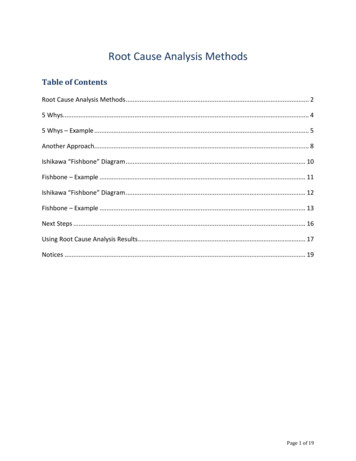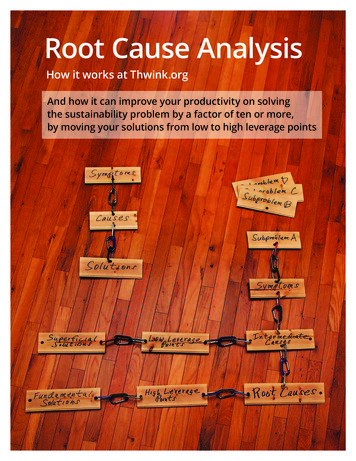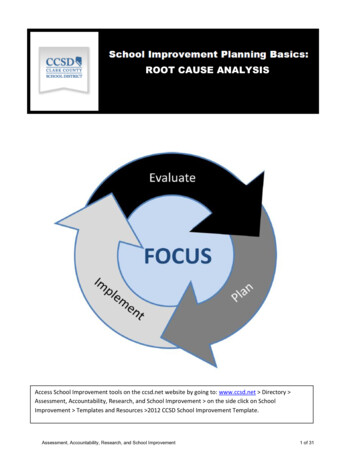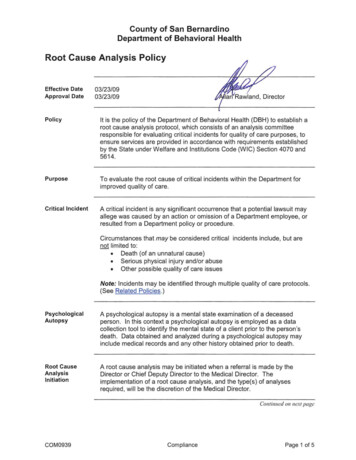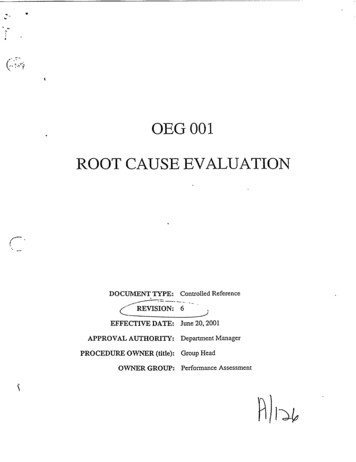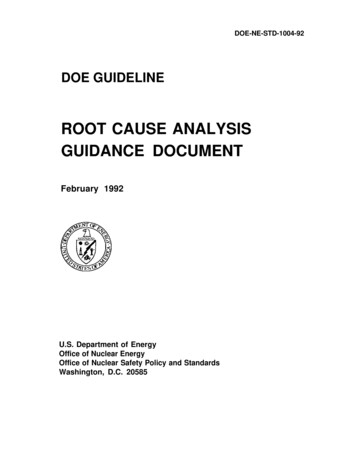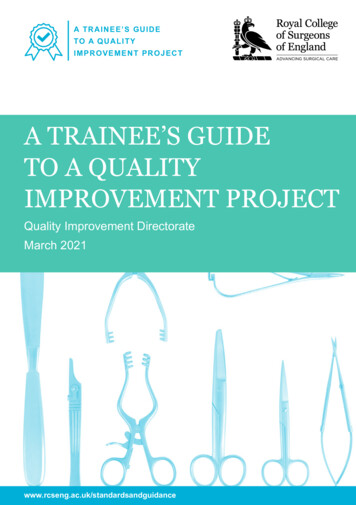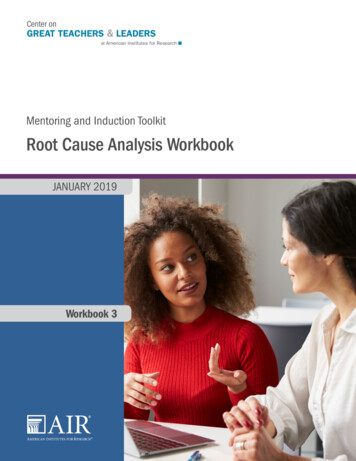
Transcription
Root Cause Analysis WorkbookPurpose: This resource is part of the Mentoring and Induction Toolkit from the Center on Great Teachers and Leaders. This toolguides school or district teams through a process to identify the root causes of the challenges addressed by mentoring and inductionprograms. By examining the root causes of these challenges, teams can identify targeted, context-specific strategies for strengtheningmentoring and induction programs. Leaders and staff members from regional comprehensive centers and state education agencies canuse this tool to facilitate conversations at the school and district levels about the design and implementation of effective mentoring andinduction programs.The root-cause analysis process in this tool was adapted from the Moving Toward Equity Root-Cause Analysis Workbook in theEquitable Access Toolkit developed by the Center on Great Teachers and Leaders (GTL Center).Step 1: Specify the Challenges to Be AddressedInstructionsReflect on the challenges that your district or school mentoring and induction program is attempting to address. Brainstorm a list ofsuch challenges, and write them in the box on the next page. Then, highlight the one challenge that seems to be the most immediateand pressing.Tips Specify the problem in terms of a particular outcome associated with mentoring and induction, such as:––Teacher retentiono Example: 45% of first- and second-year teachers left our district last yearEffective instructiono Example: On our educator effectiveness rubric, 8 out of 10 first-year teachers in our school received asummative rating of “needs improvement” at the end of last school yearCenter on Great Teachers and LeadersCopyright 2018 American Institutes for Research. All rights reserved.Root Cause Analysis Workbook—1
–Student achievemento Example: 95% of the students in the classrooms of our first and second-year teachers scored “basic” or “belowbasic” on the state reading assessment. When possible, use data to quantify the challenge. This will help with identifying root causes later on. The Data Dive Tool in theGTL Center’s Mentoring and Induction Toolkit can help your team facilitate a conversation around data related to mentoring andinduction. Although your district or school may face many challenges, highlight just one primary problematic outcome or gap for thepurposes of this exercise. Your team can come back later to conduct a root-cause analysis for the other key challenges.Brainstorm Space: ChallengesStep 2: Identify Root CausesInstructionsBrainstorm the root causes of the challenge identified in Step 1—that is, the reasons why this problematic outcome may haveoccurred. For example, is teacher retention a challenge because first- and second-year teachers are leaving or because teachers in hardto-staff areas—like science, math, and special education—are leaving?After you’ve written down one explanation for the problematic outcome, ask yourself the question “why” again. Write down apossible reason. Keep asking “why” until you seem to have exhausted the possible causes for the identified problem. It also helps toidentify the source of data that supports your reasoning—in other words, “how do you know?”Example: Take a look at the following example to see this process in action.Center on Great Teachers and LeadersRoot Cause Analysis Workbook—2
Challenge:60% of first- and second-year teachers left our school last year.Question:Why did 60% of first- and second-year teachers leave our school last year?Answer:Teachers were not satisfied with their working conditions.How do we know?Item on the teacher exit surveyQuestion:Why were teachers not satisfied with their working conditions?Answer:Teachers reported constantly having to deal with severe and persistent behavioral problems among students thatdisrupted instruction and negatively affected the school climate.How do we know?Open-ended responses on the teacher exit surveyQuestion:Why were teachers constantly dealing with severe and persistent behavioral problems among students?Answer:Many of the teachers struggle with classroom management and don’t feel confident handling these issues in theclassroom setting.How do we know?Classroom observationsQuestion:Why are teachers struggling with classroom management and lacking confidence to address behavioral problems amongstudents?Answer:Teachers are struggling because they feel like they will be penalized for asking for help from administrators.How do we know?Conversations with teachersQuestion:Why do teachers feel like they will be penalized for asking for help from administrators to manage behavioral problemsamong students?Answer:Administrators did not give clear expectations for the schoolwide behavior system at the beginning of the year.How do we know?Reflections from administratorsCenter on Great Teachers and LeadersRoot Cause Analysis Workbook—3
Tips There may be concurrent root causes. Focus on one line of inquiry at a time. When you’ve exhausted one line of inquiry, returnto the initial challenge or the early causes to see if there are other possible reasons or explanations. Focus on your locus of control. If you find yourself coming to a root cause over which you have limited control, redirect theline of inquiry, by asking “how” or “in what ways,” to come to a root cause that might be addressed in the school setting.Brainstorm Space: Root CausesStep 3: Develop a Statement of Induction Program PurposeInstructionsThe next step is to develop a statement of induction program purpose. Developing a statement of program purpose creates afoundation to ensure that the strategies used within the induction program are responsive to the root causes of identified challenges.Here is an example of a strong statement of program purpose using the example challenge and root cause from Steps 1 and 2. Challenge: 60% of first- and second-year teachers left our school last year. Root Cause: Beginning teachers are leaving our school because they struggle with classroom management, specificallybecause administrators did not set out clear expectations for the schoolwide behavior system at the beginning of the year. Statement of Induction Program Purpose: Our school will develop a mentoring and induction program to provide targetedsupport for first- and second-year teachers focused on understanding and implementing the essential components of a schoolwide Positive Behavioral Interventions & Supports (PBIS) system.Center on Great Teachers and LeadersRoot Cause Analysis Workbook—4
Tips What makes a strong statement of program purpose?–It identifies the effective instructional practices that should be continually reinforced through mentoring andinduction activities;–It addresses school or district context; and–It is used to provide consistent messaging to beginning teachers, mentors, and leaders about the focus and goals of theinduction program.Brainstorm Space: Statement of Induction Program PurposeCenter on Great Teachers and LeadersRoot Cause Analysis Workbook—5
Step 4: Categorize the CausesInstructionsLook back at the root causes that you listed in Step 2. Consider how you could group these causes into categories. List the categoriesin the box on the next page.Tip Here are some examples of categories of root causes related to teacher retention:–Lack of instructional support on specific subjects,–Poor working conditions, and–Lack of support from administrators.Brainstorm Space: Categories of Root CausesStep 5: Visualize Your Causes and CategoriesInstructionsTransfer the brainstormed causes and categories to the fishbone diagram on the next page. This diagram doesn’t have to be perfect onthe first try. You may need to create several different versions over time. Write the primary challenge (Step 1) in the red box, rootcauses (Step 2) on the black lines, and categories of root causes (Step 3) in the blue boxes.Center on Great Teachers and LeadersRoot Cause Analysis Workbook—6
Center on Great Teachers and LeadersRoot Cause Analysis Workbook—7
Step 6: Determine Strategies to Address Root CausesInstructionsConsider what specific mentoring and induction strategies could address the categories of causes. Brainstorm a list of possiblementoring and induction strategies that are matched to each root cause, and write them in the box on the next page. Afterward, discusswith your colleagues to what extent these strategies are interdependent.Tips Strategies may include things you’re already doing or new ways to enhance existing strategies. Consider strategies that align with the New Teacher Center’s High Quality Mentoring & Induction Practices:–Rigorous mentor selection based on qualities of an effective mentor,–Ongoing professional development and support for mentors,–Sanctioned time for mentor–teacher interactions,–Multiyear mentoring,–Intensive and specific guidance that moves teaching practices forward,–Professional teaching standards and data-driven conversations,–Ongoing professional development with beginning teachers,–Clear roles and responsibilities for administrators, and–Collaboration with all stakeholders.Center on Great Teachers and LeadersRoot Cause Analysis Workbook—8
Brainstorm Space: Mentoring and Induction StrategiesStep 7: Prioritize StrategiesInstructionsBased on the list of strategies generated in Step 6, prioritize no more than three strategies for implementation. Identify these strategiesin the box below.Tips Teams needing further support for implementation of prioritized strategies may want to consider completing the InductionProgram Inventory in the Toolkit as a next step to determine action steps aligned with specific strategies.Brainstorm Space: Prioritized Mentoring and Induction Strategies1.2.3.Center on Great Teachers and LeadersRoot Cause Analysis Workbook—9
Center on Great Teachers and LeadersRoot Cause Analysis Workbook—10
The root-cause analysis process in this tool was adapted from the . Moving Toward Equity Root-Cause Analysis Workbook in the Equitable Access Toolkit developed by the Center on Great Teachers and Leaders (GTL Center). St



